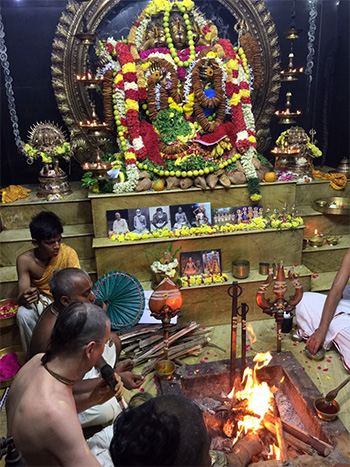Question: I am doing a project on Hinduism at school, so could you please give me some imformation on the Hindu conception of the Supreme Being.
In Hinduism the concept of the Supreme Being entails comprehension of three different divine features. Though each feature appears unique, factually they are one and the same Supreme Person. This is described in the Vedic text known as Bhagavata Purana as follows:
vadanti tat tattva-vidas
tattvam yaj jnanam advayam
brahmeti paramatmeti
bhagavan iti sabdyate
“The Absolute Truth is realized in three phases of understanding by the knower of the Absolute Truth, and all of them are identical. Such phases of the Absolute Truth are expressed as Brahman, Paramatma, and Bhagavan.”
These three features, known technically as Brahman, Paramatma and Bhagavan can be understood as follows.
Brahman is the all-pervasive impersonal form of God; Paramatma is the localized form of God within the heart of every living entity; and Bhagavan is the personal form of God who resides in His spiritual abode.
These three features are factually the same Supreme Person. This can be understood by a simple analogy as told by our spiritual master Srila Prabhupada:
“These three divine aspects can be explained by the example of the sun, which also has three different aspects, namely the sunshine, the sun’s surface and the sun planet itself. One who studies the sunshine only is the preliminary student. One who understands the sun’s surface is further advanced. And one who can enter into the sun planet is the highest. Ordinary students who are satisfied by simply understanding the sunshine-its universal pervasiveness and the glaring effulgence of its impersonal nature-may be compared to those who can realize only the Brahman feature of the Absolute Truth. The student who has advanced still further can know the sun disc, which is compared to knowledge of the Paramatma feature of the Absolute Truth. And the student who can enter into the heart of the sun planet is compared to those who realize the personal features of the Supreme Absolute Truth.”
There is another story on similar lines:
There once were three brothers who lived in a village. They had never gone to the city before, and they had no understanding of what a train was. One day they went to the city to see for themselves what a train was. As they waited they heard the sound of the train’s whistle, and they turned to another man and asked, “Is that the train?” And the man answered, “Yes.” Hearing this one of the three brothers returned to his village and told everyone that the train is the sound of a whistle. The other two brothers, not being convinced with the answer, waited, and soon they saw the head light of the train in the distance. They turned to another man and asked, “Is that light the train?” The man replied, “Yes.” Hearing this, one of the brothers was satisfied, and he returned to his village and explained how actually a train is not just a sound, but a bright light as well. After waiting some more time, the third brother saw the train pull into the station, and he was surprised at what he saw. There were doors and compartments, and so many people getting in and going out! There were food vendors, and ticket collectors, old men and young children! There was so much variety. After seeing this he was satisfied and he returned to his village to inform everyone what a train actually was. It wasn’t just an impersonal sound or a localized light. It was complete variety.
Thus the Supreme Person possesses three unique features, one impersonal and all-pervading, one localized within the hearts of all living entities, and one as a supreme individual residing in His spiritual abode. To understand the Absolute Truth, one must comprehend all three of these features simultaneously.
Receive our daily email newsletter on Hinduism, Yoga, Meditation, Ayurveda and Natural Healing.






